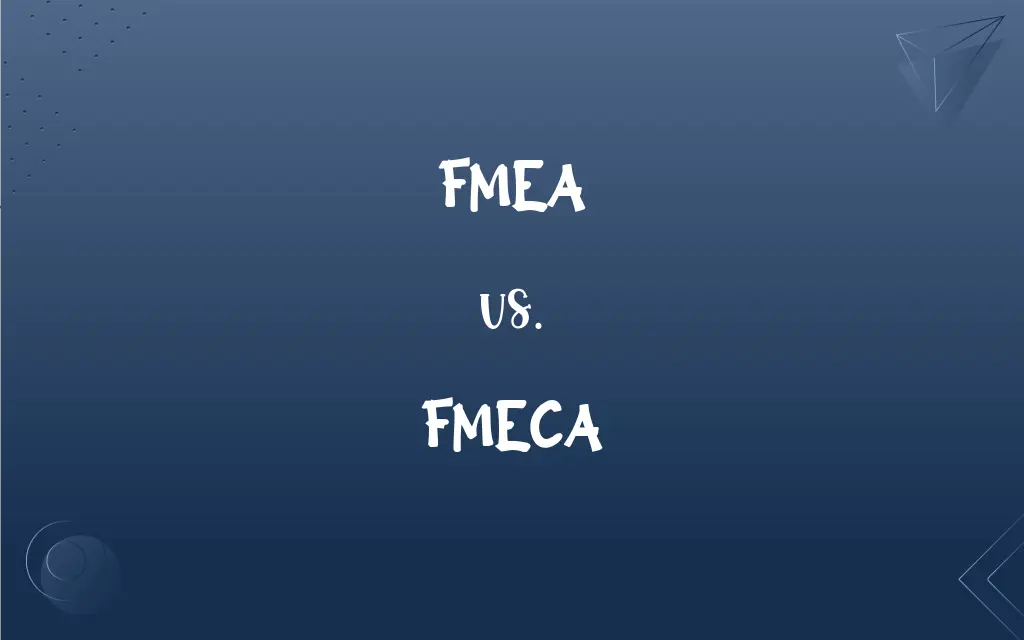FMEA vs. FMECA: What's the Difference?
Edited by Aimie Carlson || By Janet White || Published on February 6, 2024
FMEA (Failure Mode and Effects Analysis) identifies potential failure modes, while FMECA (Failure Mode, Effects, and Criticality Analysis) adds a criticality assessment to quantify their impact.

Key Differences
FMEA, or Failure Mode and Effects Analysis, is a structured approach to identifying potential failure modes in a system, product, or process. It evaluates the effects of these failures on overall system performance. Conversely, FMECA, which stands for Failure Mode, Effects, and Criticality Analysis, extends FMEA by adding a criticality assessment. This assessment quantifies the severity and likelihood of each failure, prioritizing them based on their impact.
In FMEA, the focus is primarily on identifying the ways in which a system can fail and understanding the consequences of these failures. It is a qualitative approach, where the emphasis is on brainstorming potential failure modes and their effects. FMECA, on the other hand, not only identifies these failure modes and effects but also includes a quantitative aspect. It assesses the criticality of each failure, often using a numerical ranking system, to determine the risk associated with each failure mode.
The methodology of FMEA involves creating a structured analysis of each component or process step, identifying potential failure modes, and evaluating their effects on the larger system. It does not, however, necessarily quantify the risk associated with these failures. In contrast, FMECA takes this analysis a step further by assigning a criticality level to each potential failure. This involves calculating the probability of occurrence, severity of the impact, and detectability of each failure mode.
FMEA is often used in the early stages of product design or process development to ensure reliability and safety. It helps in making informed decisions about design changes or process improvements. FMECA, being more comprehensive, is typically employed in critical systems where failure can have severe consequences. It provides a detailed understanding of each potential failure's significance, guiding more targeted and effective risk mitigation strategies.
Both FMEA and FMECA are tools used in reliability engineering and risk management, their scope and depth differ. FMEA is a qualitative tool focused on identifying potential failures and their effects. FMECA, however, includes an additional layer of analysis by quantifying the criticality of these failures, thereby providing a more detailed risk assessment.
ADVERTISEMENT
Comparison Chart
Focus
Identifies potential failure modes and their effects.
Adds criticality assessment to the identified failures.
Methodology
Qualitative analysis of failures.
Quantitative assessment of failure criticality.
Purpose
To ensure reliability and safety in early design.
For detailed risk assessment in critical systems.
Scope
Broad identification of potential failures.
Detailed evaluation including failure severity and likelihood.
Application in Design Stage
Early stage to guide design improvements.
Used in critical areas for targeted risk mitigation.
ADVERTISEMENT
FMEA and FMECA Definitions
FMEA
FMEA evaluates the effects of failures on the overall performance of a system.
During the FMEA, we realized that a single component's failure could cause the entire machine to malfunction.
FMECA
FMECA helps in making data-driven decisions for risk mitigation strategies.
Using FMECA, we prioritized the redesign of components that had the highest failure criticality.
FMEA
FMEA is used to enhance the safety and reliability of products and processes.
Implementing FMEA in our manufacturing process helped us improve product quality significantly.
FMECA
FMECA is a detailed approach to evaluating potential failures in high-risk areas.
The FMECA process revealed some overlooked risks in our nuclear plant's safety system.
FMEA
FMEA is a proactive tool for risk management in engineering and design.
By using FMEA, we were able to address vulnerabilities in our design before they led to issues.
FMECA
FMECA is used in critical systems where understanding the impact of failures is crucial.
In the aerospace industry, FMECA is essential for ensuring the safety and reliability of aircraft components.
FMEA
FMEA is a systematic process for identifying potential failure modes in a system.
The engineering team conducted an FMEA to anticipate possible failures in the new car design.
FMECA
FMECA extends FMEA by including a criticality analysis of each failure mode.
Our FMECA study showed that the criticality of the cooling system failure was higher than we anticipated.
FMEA
FMEA assists in prioritizing potential failures based on their impact.
The FMEA report highlighted which equipment failures posed the greatest risk to our operations.
FMECA
FMECA quantifies the severity and likelihood of failures in a system.
The FMECA report provided a numerical ranking for each potential failure, helping us allocate resources effectively.
FAQs
What is the purpose of FMEA?
The purpose of FMEA is to improve the reliability and safety of products and processes by identifying potential failures.
What does FMECA stand for?
FMECA stands for Failure Mode, Effects, and Criticality Analysis.
When should FMEA be conducted?
FMEA should be conducted in the early design stages of a product or process.
How does FMECA assess criticality?
FMECA assesses criticality by evaluating the probability, severity, and detectability of failures.
Why is FMECA important?
FMECA is important for quantifying the severity and likelihood of failures, especially in critical systems.
What are the steps involved in FMEA?
The steps in FMEA typically include identifying potential failures, analyzing their effects, and developing mitigation strategies.
Can FMEA prevent all failures?
While FMEA helps reduce the risk of failures, it cannot guarantee their complete prevention.
How is FMEA different from FMECA?
FMEA focuses on identifying failures and their effects, while FMECA adds a criticality assessment.
Can FMECA be used in any industry?
Yes, FMECA can be used in various industries, especially where failure risks are high.
How does FMECA help in decision-making?
FMECA helps in decision-making by providing a detailed risk assessment of potential failures.
What is FMEA?
FMEA is a method for identifying potential failure modes and their effects in systems, products, or processes.
What industries commonly use FMEA?
FMEA is widely used in automotive, aerospace, manufacturing, and healthcare industries.
Does FMECA require more resources than FMEA?
Yes, FMECA typically requires more resources due to its detailed criticality analysis.
Does FMECA replace FMEA?
No, FMECA extends FMEA by adding a criticality assessment.
What is the outcome of an FMEA analysis?
The outcome of an FMEA analysis is a list of potential failures with their effects and possible mitigation strategies.
Is training required to conduct FMEA or FMECA?
Yes, proper training and expertise are recommended for conducting FMEA or FMECA effectively.
What role does FMEA play in quality management?
FMEA plays a crucial role in quality management by identifying and mitigating potential risks in products and processes.
Are there different types of FMEA?
Yes, there are different types of FMEA, including Design FMEA (DFMEA) and Process FMEA (PFMEA).
Is FMEA a qualitative or quantitative tool?
FMEA is primarily a qualitative tool.
Can FMEA and FMECA be automated?
Some aspects of FMEA and FMECA can be automated, but they still require expert judgment and analysis.
About Author
Written by
Janet WhiteJanet White has been an esteemed writer and blogger for Difference Wiki. Holding a Master's degree in Science and Medical Journalism from the prestigious Boston University, she has consistently demonstrated her expertise and passion for her field. When she's not immersed in her work, Janet relishes her time exercising, delving into a good book, and cherishing moments with friends and family.
Edited by
Aimie CarlsonAimie Carlson, holding a master's degree in English literature, is a fervent English language enthusiast. She lends her writing talents to Difference Wiki, a prominent website that specializes in comparisons, offering readers insightful analyses that both captivate and inform.







































































